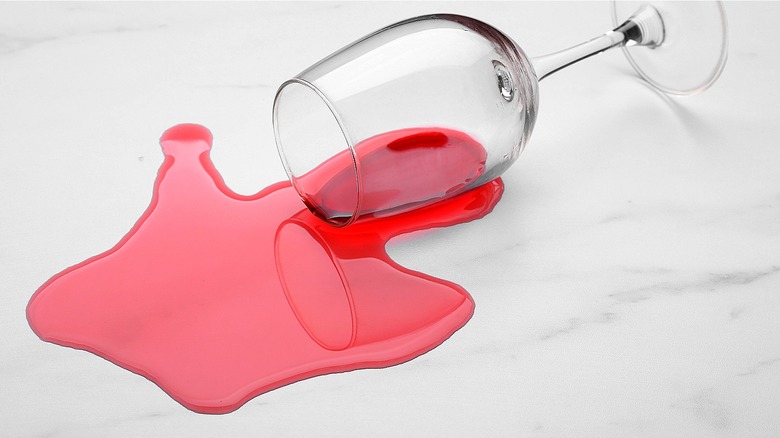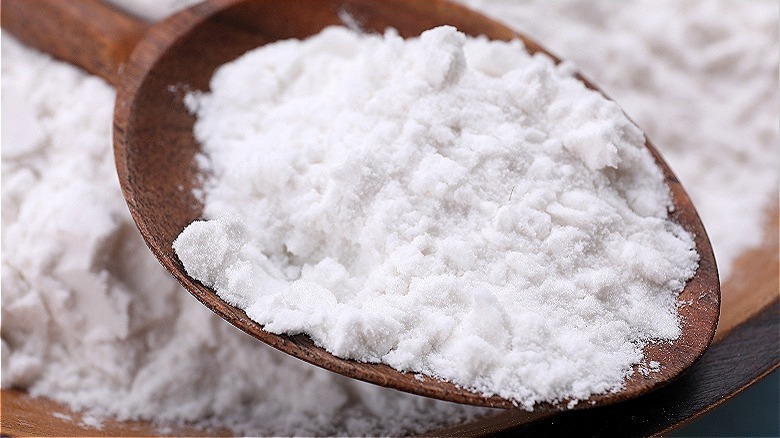How To Get Dye Stains Out Of Marble Flooring Without Any Scrubbing
Marble is a soft natural stone and porous, meaning it can absorb all kinds of liquids, including ones that stain. Even though marble is a beautiful, popular choice for kitchen countertops, bathroom vanities, and even flooring tile, any wine spill or greasy residue — among other culprits — can seep into the stone and discolor it. Many times, people might try to tackle these stains with abrasive cleaners and intense scrubbing of the marble, but that's not the best way to go about it. Marble is delicate and subject to scratching, so any abrasive materials, be they cleansers or scrubbing cloths, aren't recommended. What you need instead is a thick paste, which can be made out of everyday items, to apply as a poultice to the marble and draw the stain out of.
As the adage goes, an ounce of prevention is worth a pound of cure, which is why marble care always emphasizes wiping up any spills the moment they happen. This is certainly effective, but not always possible, as life has a way of interfering with even the best-laid plans. To ensure the long life of your marble floors, you need a way to safely clean your marble flooring of those deep-set stains as well.
Making and applying a poultice to your marble
To make a poultice for your marble floors, you want to mix water or a mild cleanser (dish soap and specialized stone cleaners both work) with a white absorbent powder such as talc or cornstarch. Use as much powder as it'll take to thoroughly cover the stain, then mix it with just enough of your liquid of choice to make a thick, creamy paste. Spread this paste over the stained area in a thick coat, like a schmear on a bagel.
As the paste sits on the marble surface over the next several hours, it'll draw the contents of the stain up into it by first dissolving the stain and then evaporating into the poultice. Once completely dry, the poultice can be swept away, bringing the stain with it. For especially deep, old, or set-in stains, multiple applications may be necessary. However, this method is completely safe on the delicate surface of the marble and will help maintain its pristine condition for decades.
Mild marble stains succumb to simple dish soap
In the event you catch the spill right after it happens, chances are the stain will be relatively mild if it's been absorbed at all. For these types of stains, all you need is a few drops of basic dishwashing soap. While commercial marble cleaners are available, save yourself the cost and trouble of finding one you like by trying dish soap first. Simply dispense a little dish soap onto a damp cleaning cloth and dab it on the stain, wiping gently to break it up and pull it off of the stone. Another option is to mix a dollop of dish soap with water in a spray bottle. Spritz a little directly onto the stain and wipe it away. Whichever way you go, however, rinse away the residue right away and dry it with a clean cloth.
Often, people will use various DIY cleaning solutions made out of vinegar or lemon juice as a way to be more ecological and savings-minded, but these types of mixtures should never be used on marble because of their high acidity. This is also the reason standard cleaners not specially designed for work on stone that contain bleach or ammonia aren't suitable for marble either. Acidic compounds eat away at the stone from the inside out as they're absorbed into the marble's many pores, permanently damaging it. One of the cons of marble flooring is its high maintenance, but if you're careful with the stone, it can stand the test of time.


